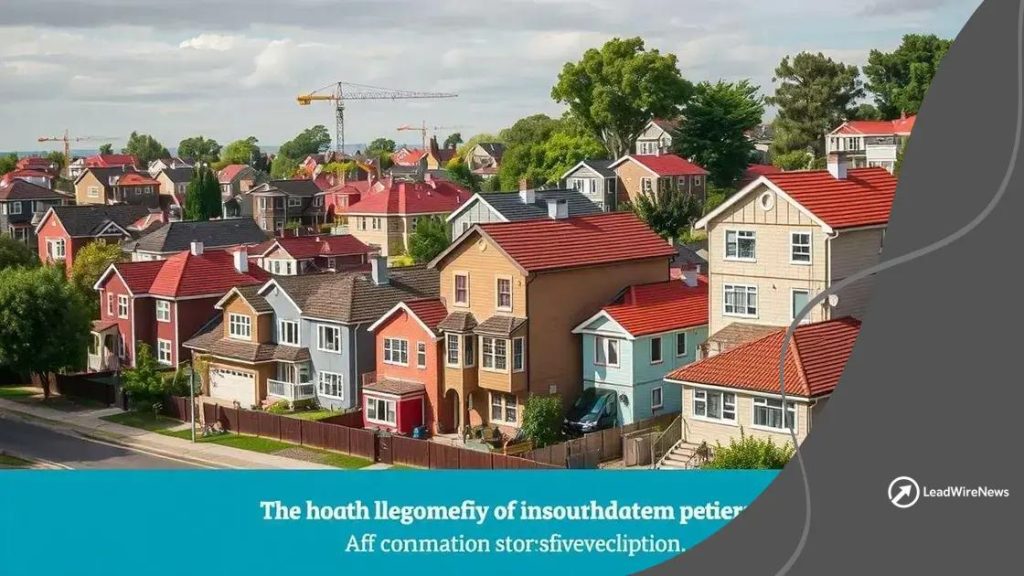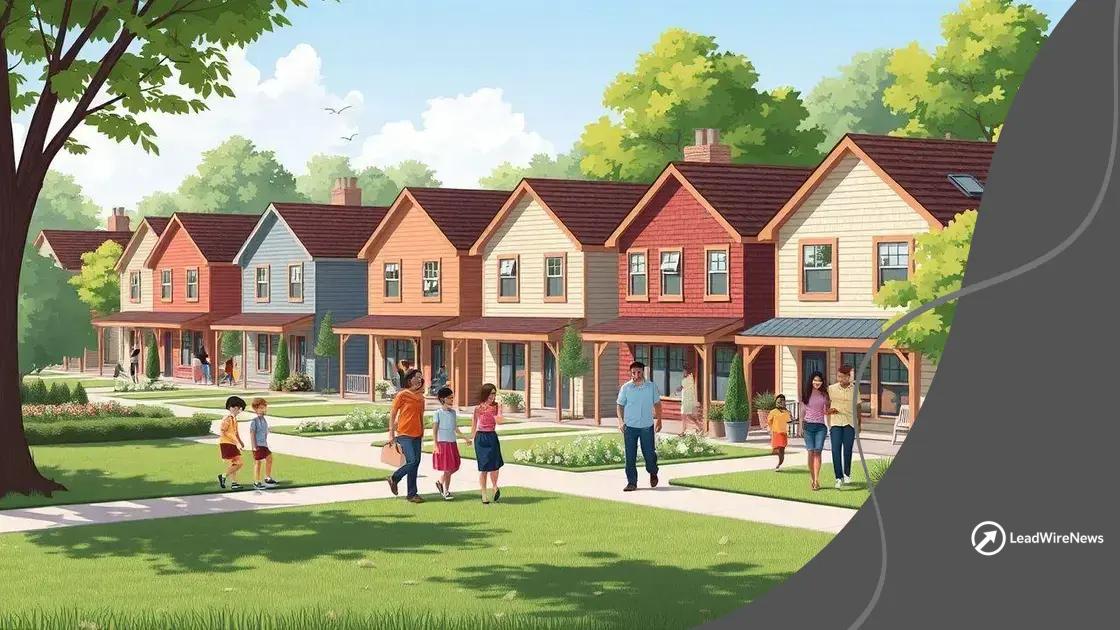Local affordable housing projects progress shaping communities

Anúncios
Local affordable housing projects address critical community needs by promoting economic growth, enhancing social inclusion, and improving infrastructure, all while facing challenges like funding limitations and community resistance.
Local affordable housing projects progress is more than just a buzzword; it represents a vital movement toward community welfare. Have you noticed how these projects are changing neighborhoods? Let’s dive into the details.
Anúncios
Understanding affordable housing initiatives
Understanding affordable housing initiatives is crucial for anyone interested in community development. These programs aim to provide quality housing options for low- to moderate-income families. They help create a more inclusive community, ensuring that everyone has a safe place to live.
The Goals of Affordable Housing Initiatives
These initiatives are designed with several key goals in mind. They strive to:
- Increase accessibility to housing for diverse populations.
- Promote sustainable development that benefits the environment.
- Empower local economies by building communities.
- Encourage mixed-income neighborhoods that foster diversity.
In many cities, affordable housing initiatives focus on revitalizing neglected areas. This not only provides homes but also improves local infrastructure and services. By investing in these communities, cities can attract new residents and businesses while preserving the culture and history of the area.
Anúncios
Types of Initiatives
Various types of programs fall under the umbrella of affordable housing. They include:
- Subsidized housing, where the government helps lower the rent for eligible residents.
- Inclusionary zoning, which requires developers to include affordable units in new projects.
- Community land trusts, where the community owns land and provides affordable housing.
- Tax credits for developers who build or renovate affordable units.
These programs are often tailored to meet the specific needs of a community. Collaboration among local governments, non-profits, and private developers is essential for success. As these partnerships grow, so do the opportunities for residents to secure affordable housing.
The Impact on Communities
Affordable housing initiatives can have a positive ripple effect on communities. They lead to better health outcomes, reduced crime rates, and enhanced educational opportunities. When families have stable housing, they are more likely to find and keep jobs, supporting their local economy.
Investing in affordable housing is a commitment to the future, providing a platform for growth and stability. These initiatives help shape not just homes, but vibrant neighborhoods that reflect the diverse fabric of our society.
Key benefits of local housing projects
Examining the key benefits of local housing projects reveals how they significantly impact communities. These projects provide not just homes but also contribute to a thriving and diverse community fabric.
Economic Growth
Local housing projects stimulate economic development. When affordable homes are built, they create jobs during the construction phase and beyond. Families moving into these homes spend money at local businesses, boosting the economy.
- Job creation through construction and supporting services.
- Increased tax revenues for the community, benefiting public services.
- Attraction of new businesses, inspired by population growth.
A stable housing market can lead to a healthier local economy, where businesses thrive alongside residents.
Social Inclusion
Another essential benefit of local housing projects is promoting social inclusion. By providing affordable options, these initiatives help integrate various demographics within a community.
- Diverse neighborhoods that encourage interaction among residents.
- Access to essential services like schools and healthcare for all income levels.
- Strengthened community bonds as people come together.
This diversity is vital for nurturing an environment where everyone feels welcome and valued, fostering a sense of belonging.
Environmental Impact
Local housing projects often focus on sustainable practices. They promote energy-efficient designs, which benefit both the planet and the residents. These initiatives aim to reduce energy costs over time, making housing more affordable in the long run.
Additionally, when projects incorporate green spaces, they provide recreational areas that improve residents’ quality of life. Communities can enjoy parks and gardens, contributing positively to mental and physical health.
Improved Infrastructure
With the development of local housing projects, infrastructure improvements often follow. More homes mean more demand for roads, public transport, and services.
- Better public transport systems that connect residents to employment and education.
- Enhanced road networks for safer and more efficient travel.
- Upgraded utilities, providing reliable services like water and electricity.
This infrastructure can lead to a higher standard of living, making neighborhoods more attractive places to live.
Recent success stories

Recent success stories in local affordable housing projects highlight the positive changes these initiatives bring to communities. They show how effective planning and execution can create thriving environments for residents.
Example of a Transformative Project
The revitalization of the downtown area in City X is a prime example. Once struggling, it now features newly built affordable housing that blends seamlessly with local businesses. Residents are enjoying increased access to parks and community centers.
- Enhanced quality of life for families moving into the area.
- Support for local businesses that now have more foot traffic.
- Improved safety and community engagement through neighborhood events.
Such transformations not only provide housing but also foster a sense of community among residents.
Community-Led Initiatives
In another inspiring case, the Community Land Trust in Town Y successfully bought and developed several parcels of land specifically for affordable units. By allowing local input and decision-making, they ensured the development met the community’s needs.
This approach has resulted in:
- Affordable options that cater directly to the town’s demographics.
- Increased community ownership of the housing process, leading to better maintenance.
- Steady population growth as people seek homes in stable neighborhoods.
Such community empowerment is essential for long-term success.
Government Partnerships
Partnerships between local governments and non-profits have also sparked success stories. For instance, a collaboration between the City Z government and a housing non-profit led to the construction of over 200 affordable units in a previously underserved area.
This project not only provided homes but improved local infrastructure:
- New schools and recreational facilities for families.
- Upgraded public transportation options making it easier for residents to commute.
- Investment in local health services to support community well-being.
The success of this partnership showcases the potential of combined efforts in addressing housing needs.
Challenges faced in implementation
Challenges faced in the implementation of local affordable housing projects can significantly impact their success. Understanding these obstacles is essential for creating effective solutions.
Funding Limitations
One major challenge is securing adequate funding. Many initiatives rely on various sources of financing, including government grants and private investments. However, fluctuations in economic conditions can limit available resources.
- Reduced government budgets can halt projects before they begin.
- Competition for funds from other community needs makes it difficult to prioritize housing.
- Funding gaps can lead to incomplete developments.
This inconsistency can delay projects, leaving communities with unmet housing needs.
Community Resistance
Resistance from local residents can also pose significant hurdles. People often have concerns about new developments, fearing they might change the character of their neighborhood.
Common reasons for resistance include:
- Concerns over property values, with existing homeowners worried that affordable projects may lead to lower prices.
- Increase in traffic and overall congestion due to new residents.
- Fear of crime associated with increased population density.
Addressing these concerns through community engagement and transparent communication is vital for moving projects forward.
Zoning and Regulatory Issues
Zoning laws and regulations can complicate the implementation of new housing projects. Inflexible zoning laws may prevent the development of affordable housing in certain areas, limiting options for builders.
These regulations can include:
- Minimum lot sizes that restrict how many units can be built.
- Zoning classifications that do not allow for multi-family housing.
- Lengthy approval processes that slow down construction timelines.
Such legal barriers can deter developers and delay much-needed housing solutions, making it crucial for local governments to advocate for reform.
Construction Challenges
Finally, logistical issues during construction play a significant role. Delays can stem from a variety of factors, including supply chain disruptions, skilled labor shortages, and weather-related setbacks.
These challenges can result in:
- Increased project costs, jeopardizing funding sources.
- Longer timelines for completion, further delaying housing availability.
- Quality concerns if rushed construction becomes necessary.
Addressing these construction issues requires effective project management and collaboration among all stakeholders.
Future outlook for affordable housing
The future outlook for affordable housing is shaped by various trends and challenges. As communities evolve, so do the strategies to meet housing needs effectively. This evolution plays a crucial role in determining how accessible and sustainable housing remains for all.
Shift Towards Sustainability
One promising trend is the growing focus on sustainable housing solutions. Developers are increasingly prioritizing eco-friendly materials and energy-efficient designs. This shift not only helps reduce environmental impact but also lowers utility costs for residents.
- Incorporating renewable energy solutions like solar panels in new builds.
- Using recycled materials to minimize waste during construction.
- Designing green spaces that enhance community well-being.
These initiatives can make affordable housing more attractive to potential residents while contributing to a healthier planet.
Technological Innovations
Advancements in technology are also influencing the future of affordable housing. From smart home technologies to construction innovations, these tools can increase efficiency and personalization.
Some notable examples include:
- 3D printing of homes, which can cut costs and build times significantly.
- Smart home features that improve energy efficiency and security.
- Data analytics being used to identify community needs and preferences.
These technologies can facilitate better planning and resource allocation, ultimately creating more suitable housing options.
Increased Collaboration
Future efforts in affordable housing will likely see more collaboration among various stakeholders. This includes local governments, non-profits, and private developers working together to solve housing challenges.
Such partnerships can enhance the efficacy of housing projects in several ways:
- Sharing resources and knowledge to maximize impact.
- Streamlining processes to speed up project completions.
- Creating affordable housing strategies that cater to local demographics.
By joining forces, stakeholders can better respond to the evolving landscape of housing needs.
Advocacy and Policy Changes
Finally, future changes in policy and advocacy efforts will play a critical role in shaping affordable housing. As awareness of housing issues grows, we can expect to see more advocacy for supportive legislation.
Key areas may include:
- Increased funding for affordable housing initiatives.
- Reform of zoning laws to make it easier to build affordable units.
- Policies supporting mixed-income developments to ensure diversity in neighborhoods.
Continued advocacy will be essential in addressing the challenges of affordable housing and ensuring its relevance in the future.
FAQ – Frequently Asked Questions about Affordable Housing Projects
What are the main benefits of local affordable housing projects?
Local affordable housing projects promote economic growth, social inclusion, and improved infrastructure, creating thriving communities.
What challenges do affordable housing projects face?
Challenges include funding limitations, community resistance, zoning issues, and construction obstacles that can delay projects.
How can technology improve affordable housing initiatives?
Technology can streamline construction processes, enhance energy efficiency, and support smart home features to improve residents’ quality of life.
What role does community engagement play in affordable housing?
Community engagement fosters trust, addresses concerns, and ensures that housing developments meet the needs of local residents.